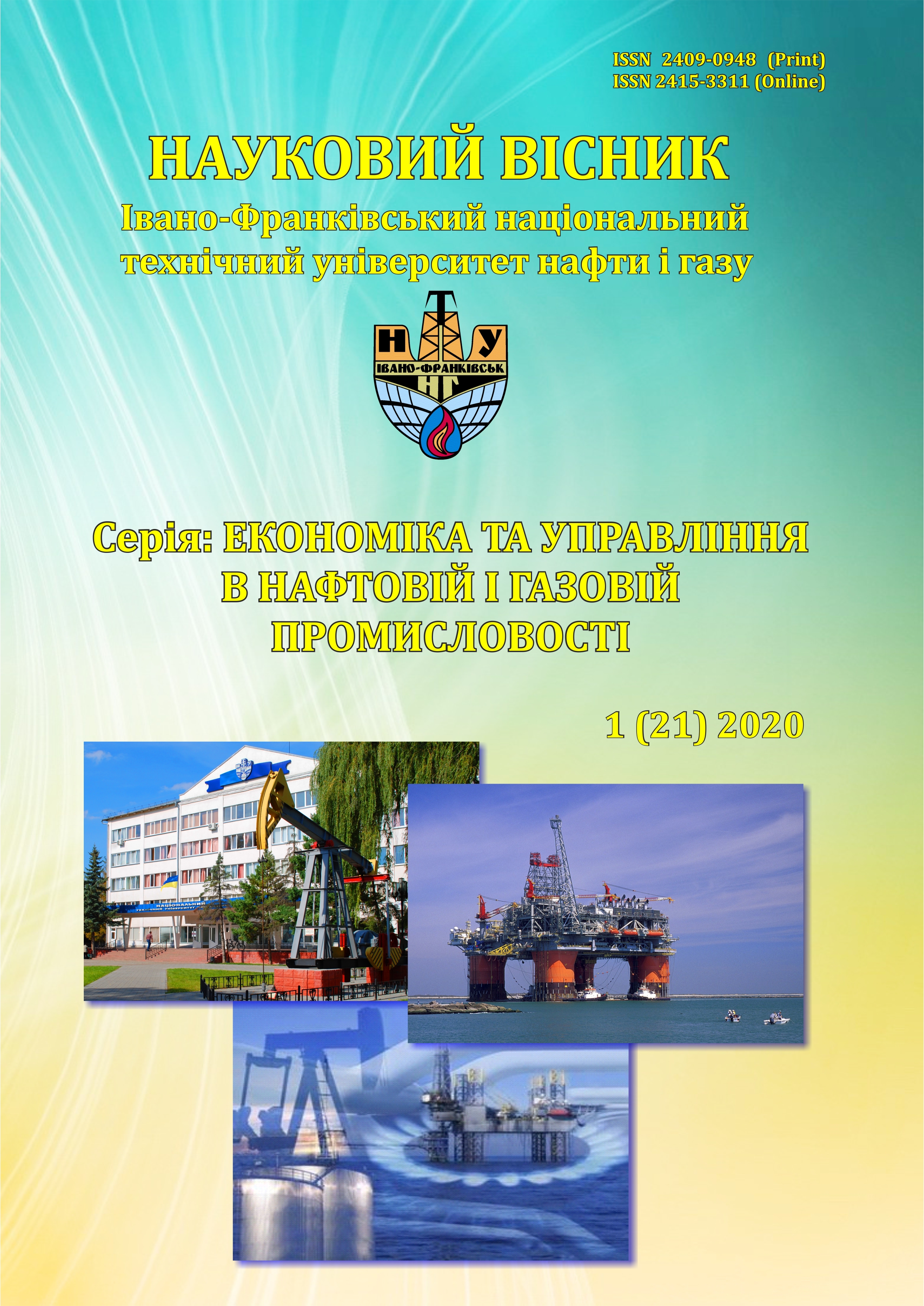DIGITALIZATION OF OIL & GAS ENTERPRISES ACTIVITIES: THE PRESENT AND THE FUTURE
DOI:
https://doi.org/10.31471/2409-0948-2020-1(21)-7-17Abstract
The article examines the digital oilfield technologies, analyzes the preconditions for the implementation of these technologies by oil and gas companies, identifies the tasks that companies need to solve on the way to the successful implementation of said technologies, and lists the consecutive steps that have enabled the successful implementation of digitization projects by the world's leading oil and gas companies. Methods of comparison, synthesis, generalization and systematic approach were used for the study.
It has been stated that the digital oilfield is a real-time monitoring and management system for oil and gas operations that provides continuous optimization of the integrated reservoir and production management model to increase hydrocarbon production, as well as reduce operating and capital costs. A number of digital technologies that have found their use in the oil and gas industry are reviewed, such as: remote real-time facility monitoring and control, real-time drilling, intelligent wells, 4-D visualization and modeling.
The preconditions for the implementation of digital technologies by oil and gas companies are explored, which include: problems with access to the required data, which creates obstacles in the analysis of important information and in the optimization of production; lack of integration between the large number of technical applications used by engineers; limited experience and risk of losing valuable knowledge of workflows; continuous changes and development of regulatory requirements for safety and environmental protection rules.
The tasks to be tackled by companies on the way to successful implementation of technologies are outlined, including: overcoming resistance to change; improving data security; avoiding data overload.
A list of consecutive steps has been formed, the realization of which has ensured the successful implementation of digitization projects by the world's leading oil and gas companies. The first sep is the development of digital oilfield concept. On the second step the ways of organizational change related to the implementation of smart technologies must be properly identified. The next step is to create an information system about changes for personnelon-field. The last step is to integrate information technologies.
It has been established that the implementation of digital oilfieldtechnologies at Ukrainian oil and gas companies should be focused around people, processes and technologies. The use of said technologies allows companies to increase production rates and quality indicators, and reduce operating costs and downtime.
References
Dmitriyevskiy, A. N., Eremin, N. A. (2018). Tsifrovaya modernizatsiya neftegazovoy ekosistemy – 2018 [Digital Modernization of the Oil and Gas Ecosystem – 2018]. Aktualnye problemy nefti i gaza - Actual Problems of Oil and Gas,21 (2), 1-12. DOI10.29222/ipng.2078-5712.2018-21.art2. [In Russian].
Sönnichsen, N. (2019).Capital expenditures on offshore exploration and production worldwide from 2017 to 2025 (in billion U.S. dollars). statista.com. Retrieved fromhttps://www.statista.com/statistics/988646/capital-expenditure-offshore-exploration-production-worldwide/.
Digital Oilfield Market Size Worth $40.21 Billion By 2025 | CAGR: 4.7%: Grand View Research, Inc. (2019). prnewswire.com. Retrieved fromhttps://www.prnewswire.com/news-releases/digital-oilfield-market-size-worth-40-21-billion-by-2025--cagr-4-7-grand-view-research-inc-300952487.html.
Groden-Morrison, A. (2019). What Is A Digital Oil Field & How Does It Work?alphasoftware.com. Retrieved fromhttps://www.alphasoftware.com/blog/the-digital-oil-field-is-the-future-of-energy.-learn-all-about-it.
Abukova, L. A., Borisenko, N. Yu., Martynov, V. G., Dmitriyevskiy, A. N., Eremin, N. A. (2017). Tsifrovaya modernizatsiya gazovogo kompleksa: nauchnye issledovaniya i kadrovoe obespecheniye [Digital modernization of the gas complex: research and staffing]. Nauchnyy zhurnal Rossiyskogo gazovogo obshchestva - Scientific journal of the Russian Gas Society,
, 3-12. istina.msu.ru. Retrieved fromhttps://istina.msu.ru/download/92678037/
jNgyC:aQHib_cVaNYcnqNxRB5aW8AKYCI/ [In Russian].
Kochkodan, V. B. (2017). Perspektyvy vykorystannia tekhnolohii intelektualnykh naftohazovykh rodovyshch v Ukraini [Perspectives of digital oilfield models implementation in Ukraine]. Prychornomorski ekonomichni studii - Black Sea Economic Studies, 16, 186-190. [InUkrainian].
Zonal Isolation Devices. (n.d.). halliburton.com. Retrieved fromhttps://www.halliburton.com/en-US/ps/well-dynamics/well-completions/intelligent-completions/zonal-isolation-devices.html.
Soma,R., Bakshi, A., Prasanna, V., DaSie, W. J., Bourgeois, B. C. (2008). Semantic web technologies for smart oil field applications. Proceedings from: Intelligent Energy Conference and Exhibition. (pp. 1-9). Society of Petroleum Engineers.DOI10.2118/112267-MS.
Sousa,David A. (Eds.). (2010). Mind, Brain, & Education: Neuroscience Implications for the Classroom.Bloomington, IN: Solution Tree.
BP: Resistance to Change is Biggest Challenge for Digital Oilfield. (2012).rigzone.com. Retrieved fromhttps://www.rigzone.com/news/oil_gas/a/116533/
bp_resistance_to_change_is_biggest_challenge_for_digital_oilfield/.
Mehta, M. (2012). Technologies for expanding horizon of digital oil field.hartenergy.com. Retrieved fromhttps://www.hartenergy.com/exclusives/technologies-expanding-horizon-digital-oil-field-19092.
Huawei & VF: Exploring the Needs of the Digital Oilfield. (2013). Newbury, Berkshire:Vodafone Group. e-file.huawei.com. Retrieved fromhttp://e-file.huawei.com/en/
material/MaterialDownload?materialid=4384f0c761cb4f7d993a864e419b4e94&language=en.
Downloads
Published
How to Cite
Issue
Section
License
Copyright and Licensing Terms
Copyright Statement
The authors who publish in the journal accept the following conditions:
- The authors retain the copyright and grant the journal the right of first publication, licensed with Creative CommonsCC BY-NC-SA , which permits other people to remix, transform, and build upon the material and use the material for non-commercial purposes, give appropriate credit and distribute the contributions under the same license as the original.
- The authors can conclude additional agreements on the non-exclusive distribution of the journal’s published version of the work (for example, publication of the work in electronic repositories) with an acknowledgment of its initial publication in this journal.
- The authors can upload the published articles on the Internet (for example, in electronic repositories or on web-sites), as it will stimulate fruitful scholarly discussions and increase the citation rates of the published articles.


1.png)


1.png)





